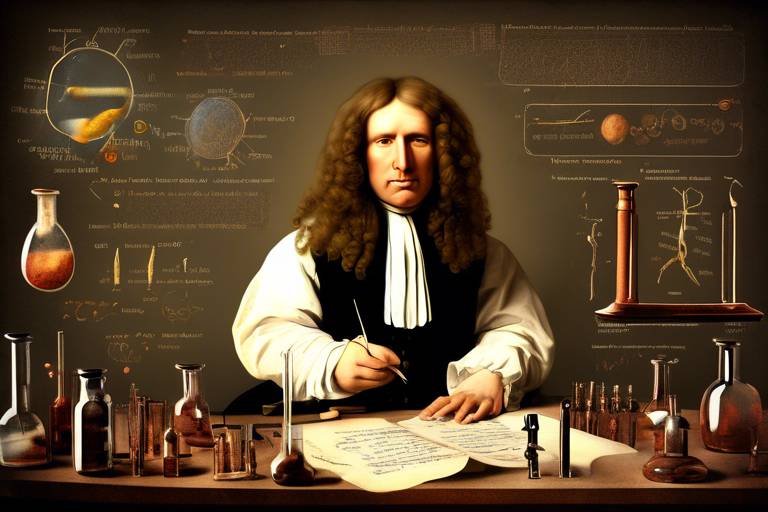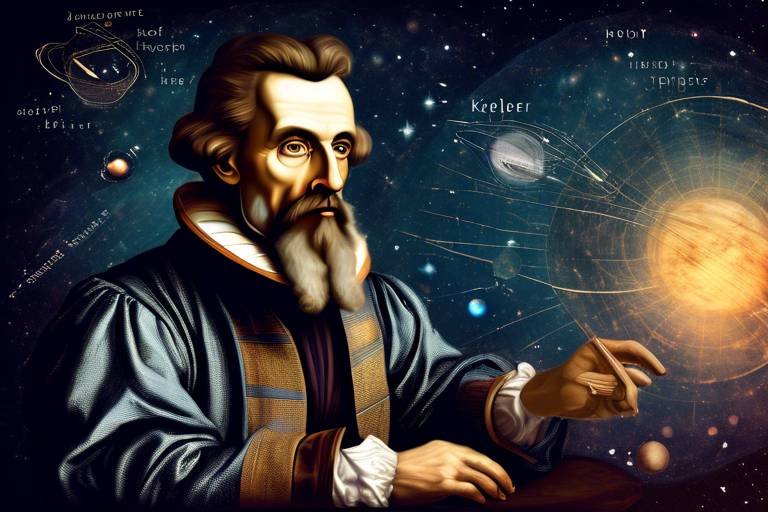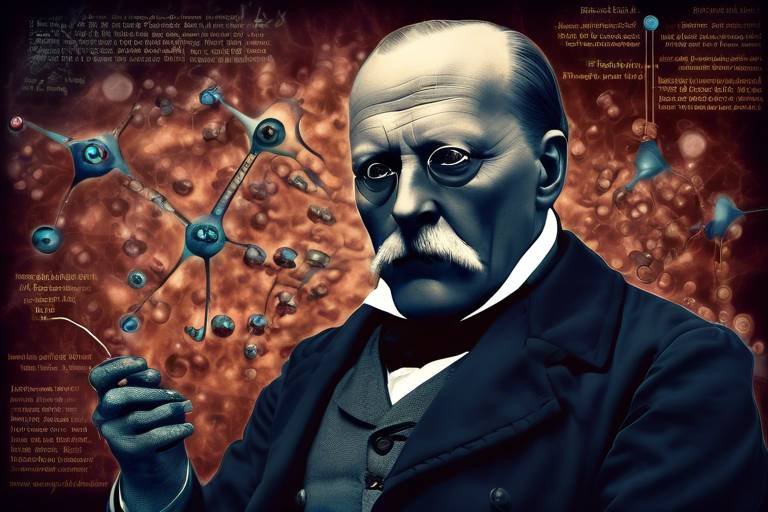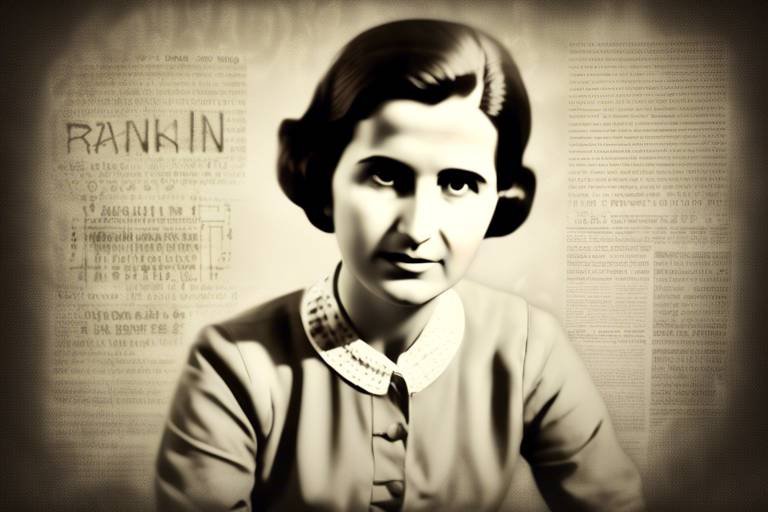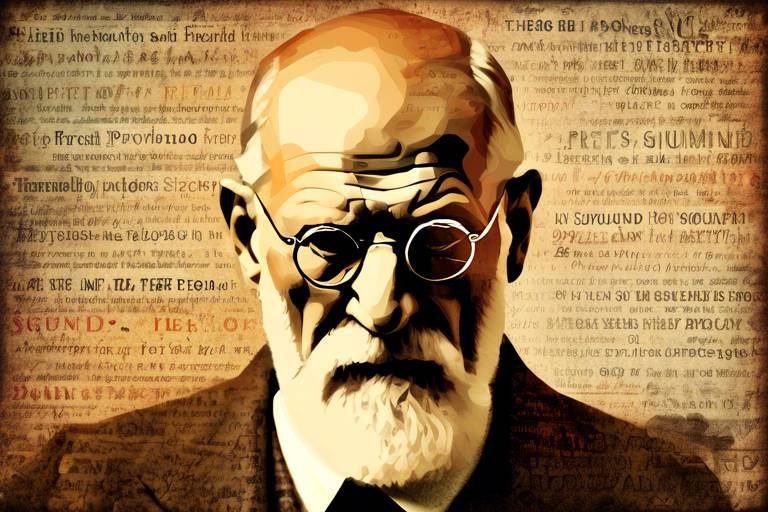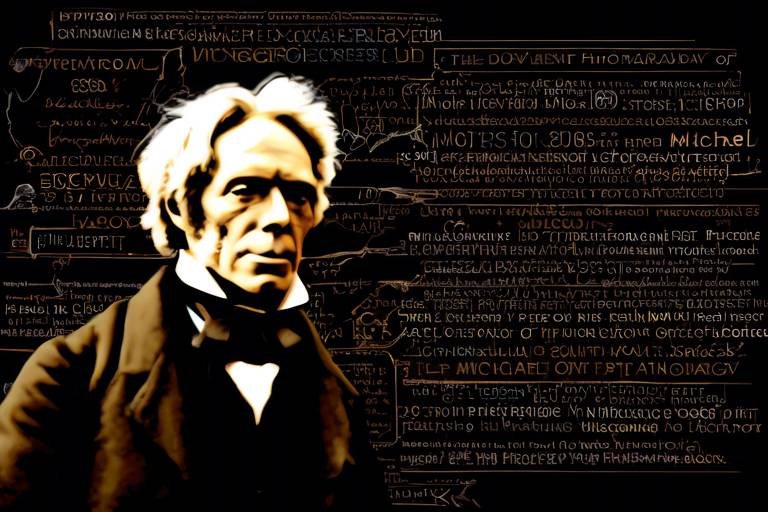The Discoveries of Antonie van Leeuwenhoek in Microbiology
Antonie van Leeuwenhoek, often hailed as the father of microbiology, embarked on a journey that would forever change our understanding of the microscopic world. His discoveries opened a new frontier in science, revealing a hidden realm teeming with life that had previously gone unnoticed. Imagine peering through a tiny lens and seeing a universe of tiny creatures, each playing a role in the grand tapestry of life! Van Leeuwenhoek's pioneering work not only laid the foundation for microbiology but also sparked curiosity and wonder about the unseen organisms that inhabit our world.
Born in 1632 in Delft, Netherlands, van Leeuwenhoek started his career as a merchant, but his insatiable curiosity and passion for science led him down a different path. He had no formal education in the sciences, yet his ingenuity and determination propelled him to become a self-taught microscopist. He crafted his own microscopes, using his skills in glassmaking to create lenses that could magnify objects up to 300 times their actual size. This was a significant leap forward in scientific observation, allowing him to explore the intricate details of life at a scale that was previously unimaginable.
As he delved deeper into his studies, van Leeuwenhoek employed various methods of observation that set him apart from his contemporaries. He meticulously prepared samples, often using saliva, pond water, and other natural substances, to capture the essence of microscopic life. His keen eye for detail and innovative techniques enabled him to document his findings with precision. Van Leeuwenhoek's observations revealed a stunning array of microorganisms, including bacteria, protozoa, and spermatozoa. Each discovery was a revelation, illuminating the complex interactions that occur in nature.
One of the remarkable aspects of van Leeuwenhoek's work was his ability to communicate his findings. He wrote detailed letters to the Royal Society in London, sharing his observations and inviting others to explore the microscopic world. His enthusiasm was infectious, and his letters ignited a wave of interest in microscopy and microbiology. The implications of his work were profound, as they challenged existing notions of life and paved the way for future scientific inquiry.
In conclusion, Antonie van Leeuwenhoek's contributions to microbiology are nothing short of revolutionary. His passion, ingenuity, and relentless pursuit of knowledge transformed our understanding of the microscopic world. As we continue to explore the intricacies of life at the cellular level, we owe a debt of gratitude to van Leeuwenhoek for his groundbreaking discoveries that have shaped the field of microbiology as we know it today.
- What did Antonie van Leeuwenhoek discover? Van Leeuwenhoek discovered various microorganisms, including bacteria, protozoa, and spermatozoa, through his innovative use of microscopes.
- How did van Leeuwenhoek's work influence modern science? His discoveries laid the foundation for microbiology and inspired future generations of scientists to explore the microscopic world.
- What materials did van Leeuwenhoek use for his observations? He used natural substances like pond water, saliva, and other biological samples to observe microorganisms.

The Life of Antonie van Leeuwenhoek
Antonie van Leeuwenhoek, often hailed as the father of microbiology, was born on October 24, 1632, in Delft, Netherlands. He came from humble beginnings, being the son of a basket maker. His early life was marked by modesty and simplicity; however, it was his insatiable curiosity and knack for observation that would set him on a path towards scientific greatness. Although he received little formal education, his passion for learning led him to become a skilled tradesman, particularly in the field of lens crafting.
Van Leeuwenhoek's journey into the world of microscopy began in the late 1650s when he started experimenting with lenses. His fascination with the microscopic world was ignited by his work as a draper, where he used magnifying glasses to inspect the quality of fabrics. This hands-on experience with lenses allowed him to develop a unique understanding of optics, which he would later apply to create his own microscopes. His first major breakthrough came when he constructed a simple yet effective microscope that could magnify objects up to 200 times their actual size. This was a remarkable feat for the time and opened the door to a realm of discovery that was previously unimaginable.
Despite his lack of formal scientific training, van Leeuwenhoek's meticulousness and attention to detail were unparalleled. He often referred to himself as a "curious observer," and it's this mindset that drove him to explore the unseen world around him. His observations were not merely casual; they were documented with precision and care. Van Leeuwenhoek would often write letters to the Royal Society of London, sharing his findings and captivating the scientific community with descriptions of microorganisms he had observed in water, dental plaque, and even in his own bodily fluids.
Throughout his life, van Leeuwenhoek remained a humble figure, often working in isolation. He never sought fame or fortune; instead, he was motivated by a profound desire to understand the intricacies of life. His dedication to his craft is evident in his extensive correspondence, where he detailed his discoveries and methods, paving the way for future scientists to build upon his work. In fact, it's said that he never considered himself a scientist in the modern sense; rather, he viewed himself as a simple tradesman who stumbled upon the wonders of the microscopic world.
As he aged, van Leeuwenhoek continued to refine his techniques and improve his microscopes. He lived a long life, passing away on August 26, 1723, leaving behind a legacy that would influence generations of scientists. His contributions to the field of microbiology were not just groundbreaking; they were revolutionary, laying the very foundation for the study of microorganisms. Today, we remember Antonie van Leeuwenhoek not just for his discoveries, but for his unwavering spirit of inquiry and his relentless pursuit of knowledge.

Antonie van Leeuwenhoek's journey into the world of microscopy is nothing short of fascinating. Imagine a time when the tiniest forms of life were completely invisible to the naked eye, and yet, through sheer determination and ingenuity, one man changed that forever. Van Leeuwenhoek, a Dutch tradesman, was not a formally trained scientist; rather, he was a self-taught individual fueled by curiosity. His passion for observation led him to experiment with lenses, and through this exploration, he invented microscopes that would open up an entirely new realm of scientific discovery.
What set van Leeuwenhoek apart was not just his keen interest but also his exceptional skill in crafting lenses. He meticulously ground and polished glass into powerful magnifying lenses that could achieve astonishing levels of magnification—far beyond what was available at the time. His early microscopes were simple, consisting of a single lens mounted in a holder, but they were revolutionary. These devices allowed him to observe microorganisms for the first time, revealing a hidden world that had previously eluded humanity.
Van Leeuwenhoek's microscopes varied in design, but they shared a few key characteristics that made them unique:
- Single-Lens Design: Unlike the compound microscopes of his contemporaries, van Leeuwenhoek's microscopes utilized a single, high-quality lens that provided clearer images.
- Handcrafted Precision: Each lens was crafted with meticulous attention to detail, allowing for unprecedented clarity and magnification.
- Simple Construction: His microscopes were straightforward in design, making them accessible for personal use and experimentation.
One of the most remarkable aspects of van Leeuwenhoek's microscopes was their ability to magnify objects up to 300 times their original size. This level of magnification was unheard of at the time and allowed him to see things like bacteria, protozoa, and even the structure of human sperm. The implications of these discoveries were profound, as they challenged existing notions of life and biology.
In addition to his innovative designs, van Leeuwenhoek was a master of observation. He understood how to prepare samples effectively and utilized natural light to enhance visibility. This attention to detail in both the construction of his microscopes and his methods of observation set the stage for future advancements in microbiology.
As we reflect on van Leeuwenhoek's contributions, it's important to appreciate the sheer audacity of his work. He took a simple tool—the microscope—and transformed it into a gateway to a world that was previously unimaginable. His legacy is not just in the discoveries he made but also in the inspiration he provided to countless scientists who followed in his footsteps.

Antonie van Leeuwenhoek was not just a curious mind; he was a meticulous observer who transformed the way we understand the microscopic world. His methods of observation were revolutionary, allowing him to peer into realms that were previously invisible to humanity. Imagine being the first person to see a world teeming with life, hidden in a drop of water! Van Leeuwenhoek's approach was multi-faceted, involving a combination of innovative techniques and a deep understanding of light and optics.
One of the key elements of van Leeuwenhoek's observational methods was his ability to prepare samples meticulously. He would often take a drop of water from ponds, rainwater, or even his own mouth, and place it under his handcrafted microscope. This was no simple task; he had to ensure that the samples were not contaminated and were representative of the environment he was studying. The precision in his sample preparation was akin to that of a chef preparing a gourmet dish, where every ingredient matters.
To enhance visibility, van Leeuwenhoek utilized natural light in a way that was ahead of his time. Unlike modern microscopes that use complex lighting systems, he relied on sunlight, directing it through his lenses to illuminate the specimens. This technique not only made the microorganisms visible but also allowed him to observe their movements in real-time. Imagine watching tiny creatures swim and dart about, as if you were witnessing a bustling city under a microscope!
Moreover, van Leeuwenhoek's keen eye for detail was complemented by his innovative use of glass. As a skilled glassmaker, he crafted lenses that were far superior to anything available during his time. His lenses were made with great care, often polished to perfection, enabling him to achieve magnifications that left his contemporaries in awe. The clarity and sharpness of his observations were so remarkable that he could distinguish between different types of microorganisms, such as bacteria and protozoa, which was groundbreaking.
In addition to his lens-making skills, van Leeuwenhoek also experimented with different shapes and curvatures of lenses. This experimentation was crucial; it allowed him to create microscopes that could focus light in ways that enhanced the visibility of the tiniest organisms. His dedication to perfecting his craft was like that of an artist refining their technique, ensuring that every brush stroke contributes to the masterpiece.
In summary, van Leeuwenhoek's methods of observation were characterized by meticulous sample preparation, innovative use of natural light, and exceptional lens crafting. His techniques not only paved the way for future scientists but also opened up a whole new world of discovery. The microscopic universe that he unveiled was filled with astonishing forms of life, forever changing our understanding of biology and the very nature of existence.
- What types of microorganisms did van Leeuwenhoek discover?
Van Leeuwenhoek discovered various microorganisms, including bacteria, protozoa, and spermatozoa. - How did van Leeuwenhoek's work influence modern microbiology?
His meticulous observations and discoveries laid the groundwork for the field of microbiology, inspiring future research and advancements. - Why is van Leeuwenhoek considered the father of microbiology?
He is considered the father of microbiology due to his pioneering use of the microscope to observe and describe microorganisms for the first time.

Antonie van Leeuwenhoek was not just a curious mind; he was also a skilled glassmaker, and this talent played a pivotal role in his groundbreaking work in microbiology. Imagine trying to explore a world that is invisible to the naked eye, a world filled with tiny organisms that could change our understanding of life itself. Van Leeuwenhoek's expertise in glassmaking allowed him to craft lenses that were not only functional but revolutionary for their time. His ability to manipulate glass gave him the tools necessary to create microscopes that achieved unprecedented levels of magnification, enabling him to observe microorganisms in ways that had never been possible before.
In a time when most lenses were poorly made and offered limited clarity, van Leeuwenhoek's glassmaking skills set him apart. He understood the importance of lens quality and the impact it had on visibility. By carefully shaping and polishing his glass, he was able to produce lenses that provided a clearer view of the microscopic world. This meticulous attention to detail was crucial; after all, how could one hope to discover the secrets of tiny organisms without the right tools? His lenses allowed him to see bacteria, protozoa, and even spermatozoa, changing the course of science forever.
Moreover, van Leeuwenhoek's background in glassmaking contributed to his innovative approach. He was not merely a scientist; he was also an artisan who understood the properties of glass and light. This unique combination of skills led him to experiment with different shapes and thicknesses of lenses, resulting in microscopes that were capable of magnifying objects up to 200 times. To put this into perspective, think of it as having a superpower that lets you see a world that is normally hidden from view. His passion for glassmaking and his relentless pursuit of knowledge drove him to create instruments that would lay the foundation for future advancements in microscopy.
In addition to crafting lenses, van Leeuwenhoek's knowledge of glassmaking allowed him to innovate in other areas. For instance, he developed techniques for mounting specimens on slides that enhanced their visibility under the microscope. This attention to specimen preparation was just as important as the lenses themselves. By ensuring that each sample was properly positioned and illuminated, he could maximize the clarity of his observations. His innovative methods not only improved his own work but also set a standard for future scientists who would follow in his footsteps.
To summarize, the role of glassmaking in Antonie van Leeuwenhoek's work cannot be overstated. His skills as a glassmaker were instrumental in the development of high-quality microscopes that revolutionized the field of microbiology. Without his expertise and passion for craftsmanship, the microscopic world may have remained a mystery for much longer. The legacy of his glassmaking endeavors continues to influence scientists today, reminding us of the profound connection between art and science.
- What was Antonie van Leeuwenhoek's main contribution to microbiology? Van Leeuwenhoek is known as the father of microbiology for his pioneering discoveries of microorganisms using his handcrafted microscopes.
- How did van Leeuwenhoek's glassmaking skills impact his discoveries? His expertise in glassmaking allowed him to create high-quality lenses that enabled unprecedented magnification and clarity in microscopic observations.
- What types of microorganisms did van Leeuwenhoek discover? He discovered various microorganisms, including bacteria, protozoa, and spermatozoa, which greatly advanced the understanding of life.
- Why is van Leeuwenhoek considered an important figure in science? His meticulous observations and documentation laid the groundwork for the field of microbiology, inspiring future generations of scientists.

Antonie van Leeuwenhoek was not just a curious observer; he was a true innovator in the realm of lens crafting. His ability to create high-quality lenses was pivotal in the advancement of microscopy. Imagine trying to look at a tiny world through a foggy window—this was the challenge scientists faced before van Leeuwenhoek came along. He changed the game by developing lenses that provided clarity and magnification previously thought impossible.
One of the key innovations van Leeuwenhoek implemented was the use of single-lens microscopes. Unlike the compound microscopes of his time, which used multiple lenses and often produced distorted images, van Leeuwenhoek's simple design allowed for a more direct observation of specimens. This was a revelation! His lenses could magnify objects up to 300 times, enabling him to discover microorganisms that were invisible to the naked eye.
To achieve such remarkable magnification, van Leeuwenhoek meticulously crafted his lenses from glass. He would take small pieces of glass and grind them down to create a convex shape. This process required immense skill and precision. In fact, van Leeuwenhoek's background as a glassmaker played a critical role in his success. His understanding of light refraction and the properties of glass allowed him to produce lenses that were not only powerful but also capable of producing clear images.
Moreover, van Leeuwenhoek's lenses were unique in their curvature. He experimented with different shapes, which resulted in lenses that could focus light more effectively. This innovation was akin to having a finely tuned instrument that could reveal the hidden details of life. His careful attention to detail and relentless pursuit of improvement led to the creation of high-quality lenses that set a new standard for scientific observation.
In addition to his lens-making techniques, van Leeuwenhoek also emphasized the importance of sample preparation. He understood that the way a specimen was prepared could significantly impact what was observed. By using thin slices of material, he ensured that light could pass through more easily, enhancing the visibility of microorganisms. This meticulous approach underscores his dedication to accuracy and detail, which is a hallmark of scientific inquiry.
Overall, Antonie van Leeuwenhoek's innovations in lens crafting were not just technical achievements; they were the keys that unlocked the door to a previously unseen world. His work laid the groundwork for future advancements in microscopy and opened the eyes of scientists to the vast and intricate universe of microorganisms. Thanks to his pioneering spirit, we now have a deeper understanding of life at the microscopic level.
- What were Antonie van Leeuwenhoek's main contributions to microbiology?
Van Leeuwenhoek is known for his discoveries of bacteria, protozoa, and spermatozoa, which he observed through his handcrafted microscopes. - How did van Leeuwenhoek's lens crafting techniques differ from those of his contemporaries?
Unlike compound microscopes, van Leeuwenhoek used single lenses that provided clearer images and higher magnification. - What impact did van Leeuwenhoek's work have on future scientific research?
His discoveries inspired future generations to explore the microscopic world, leading to significant advancements in biology and medicine.

Antonie van Leeuwenhoek’s contributions to microbiology are nothing short of revolutionary. With his handcrafted microscopes, he ventured into a world that was previously hidden from human eyes. Imagine looking through a window into a universe teeming with life, where bacteria, protozoa, and even spermatozoa danced under the lens of his microscope. Each discovery opened a new chapter in our understanding of life itself, challenging the very foundations of biology.
One of the most groundbreaking discoveries made by van Leeuwenhoek was the observation of bacteria. He famously referred to them as "animalcules," a term that evokes a sense of wonder and curiosity about these tiny organisms. Using his meticulously crafted lenses, he was able to identify various shapes and sizes of bacteria, which laid the groundwork for future studies in microbiology. This was a significant leap forward, as it shifted the scientific perspective on microorganisms from mere speculation to tangible evidence.
In addition to bacteria, van Leeuwenhoek also discovered protozoa, single-celled organisms that play critical roles in various ecosystems. His keen observations revealed a vibrant world of life forms that were previously unknown, showcasing the diversity of life at a microscopic level. He documented these findings with remarkable detail, often sketching what he saw, which provided invaluable insights for future scientists.
Another significant discovery was that of spermatozoa, which van Leeuwenhoek observed in various species. This was a pivotal moment in the study of reproduction, as it introduced the concept of fertilization at a microscopic level. His findings suggested that life could be traced back to these tiny cells, fundamentally altering our understanding of biology and reproduction.
To give you a clearer picture of van Leeuwenhoek's discoveries, here’s a quick overview:
| Microorganism | Discovery Year | Significance |
|---|---|---|
| Bacteria | 1676 | Introduced the concept of microorganisms, changing the understanding of disease and hygiene. |
| Protozoa | 1674 | Highlighted the diversity and complexity of life at the microscopic level. |
| Spermatozoa | 1677 | Revolutionized the understanding of reproduction and fertilization. |
Van Leeuwenhoek's meticulous documentation and observations not only contributed to the scientific community of his time but also inspired future generations. His work sparked curiosity and a desire to explore the microscopic world, leading to advancements in various fields such as medicine, biology, and public health. His discoveries laid the groundwork for understanding how microorganisms affect our health and the environment, making him a pivotal figure in the history of science.
In summary, Antonie van Leeuwenhoek’s discoveries in microbiology were groundbreaking and transformative. By unveiling the hidden world of microorganisms, he not only expanded our knowledge but also challenged the scientific community to rethink its understanding of life itself. His legacy is a testament to the power of curiosity and innovation in the pursuit of knowledge.
- What did Antonie van Leeuwenhoek discover?
He discovered bacteria, protozoa, and spermatozoa, among other microorganisms, using his handcrafted microscopes. - Why is van Leeuwenhoek considered the father of microbiology?
His pioneering work in observing and documenting microorganisms laid the foundation for the field of microbiology. - How did van Leeuwenhoek's discoveries impact public health?
His findings contributed to a better understanding of diseases and the importance of hygiene in preventing infections.

Antonie van Leeuwenhoek's contributions to microbiology have had a profound and lasting impact on the field of science. His meticulous observations and groundbreaking discoveries opened a whole new world that was previously hidden from human eyes. Before van Leeuwenhoek, the microscopic realm was largely a mystery, and many scientists were skeptical about the existence of microorganisms. However, his work not only confirmed their existence but also paved the way for a deeper understanding of life itself.
One of the most significant impacts of van Leeuwenhoek's work is how it laid the groundwork for future research in microbiology. His discoveries of various microorganisms, including bacteria, protozoa, and spermatozoa, challenged existing scientific paradigms and encouraged other scientists to explore the microscopic world. This curiosity ignited a series of advancements in the field, leading to the establishment of microbiology as a distinct scientific discipline.
Furthermore, van Leeuwenhoek's meticulous documentation of his findings served as a model for scientific inquiry. His detailed letters to the Royal Society of London not only communicated his discoveries but also exemplified the importance of observation and experimentation in scientific research. This practice of sharing findings and methodologies has become a cornerstone of scientific progress, inspiring countless researchers to follow in his footsteps.
In addition to influencing the field of microbiology, van Leeuwenhoek's work has had significant implications for public health. His observations of microorganisms highlighted the role these tiny entities play in disease. By recognizing that microscopic organisms could be responsible for infections, van Leeuwenhoek’s work contributed to the development of hygiene practices that are crucial in preventing the spread of diseases. This understanding eventually led to advancements in sanitation, vaccination, and medical microbiology, which have saved countless lives over the centuries.
To illustrate the impact of van Leeuwenhoek's discoveries, consider the following table that summarizes key areas influenced by his work:
| Impact Area | Description |
|---|---|
| Scientific Methodology | Encouraged systematic observation and documentation of findings. |
| Public Health | Informed hygiene practices and understanding of disease transmission. |
| Microbiology | Established microbiology as a distinct scientific discipline. |
| Inspiration for Future Research | Motivated scientists to explore and study microorganisms further. |
In conclusion, the impact of Antonie van Leeuwenhoek's work extends far beyond his time. His pioneering spirit and dedication to uncovering the hidden intricacies of life have left an indelible mark on science. By inspiring future generations of scientists and contributing to advancements in public health, van Leeuwenhoek's legacy continues to thrive, reminding us of the importance of curiosity and exploration in the world of science.
- What did Antonie van Leeuwenhoek discover?
Van Leeuwenhoek discovered various microorganisms, including bacteria, protozoa, and spermatozoa, using his innovative microscopes. - How did van Leeuwenhoek's work influence public health?
His observations highlighted the role of microorganisms in diseases, leading to better hygiene practices and advancements in public health. - Why is van Leeuwenhoek considered the father of microbiology?
He is regarded as the father of microbiology due to his pioneering discoveries and the foundational principles he established in the study of microorganisms.

Antonie van Leeuwenhoek was not just a pioneer in microbiology; he was also a beacon of inspiration for future scientists. His relentless curiosity and innovative spirit set a precedent that many aspiring researchers would follow. Can you imagine the excitement of peering through a microscope for the first time and discovering a whole new world? That's precisely what van Leeuwenhoek did, and his journey sparked a wave of enthusiasm for scientific exploration that continues to resonate today.
One of the most remarkable aspects of van Leeuwenhoek's work was his unwavering dedication to observation. He meticulously documented his findings, detailing the shapes and behaviors of microorganisms in a way that was both accessible and engaging. This level of detail not only showcased his passion but also encouraged others to adopt a similar approach. As a result, many scientists were inspired to take up the microscope and delve into the microscopic realm, eager to uncover the mysteries that lay hidden from the naked eye.
Moreover, van Leeuwenhoek's discoveries laid the groundwork for future microbiologists. His identification of bacteria, protozoa, and spermatozoa opened up new avenues for research that would lead to significant breakthroughs in various fields, including medicine and environmental science. The implications of his work were profound, as they highlighted the importance of microorganisms in both health and disease, prompting future generations to explore these tiny entities further.
In a world that often feels disconnected from the wonders of nature, van Leeuwenhoek's legacy serves as a reminder that curiosity and determination can lead to groundbreaking discoveries. His story encourages young scientists to embrace their inquisitive nature, to ask questions, and to seek answers through observation and experimentation. After all, the journey of discovery is as important as the findings themselves!
As we reflect on van Leeuwenhoek's impact, it's clear that his contributions went beyond the microscope. He ignited a passion for science that transcended his time, inspiring countless individuals to pursue careers in research and innovation. Today, as we continue to explore the microscopic world, we owe a debt of gratitude to this remarkable man who dared to look closer and see what others could not.
- What was Antonie van Leeuwenhoek's most significant discovery?
Van Leeuwenhoek is best known for his discovery of bacteria, protozoa, and spermatozoa, which fundamentally changed our understanding of life. - How did van Leeuwenhoek's work influence modern science?
His meticulous observations and detailed documentation laid the foundation for microbiology, inspiring future scientists to explore the microscopic world. - What techniques did van Leeuwenhoek use in his observations?
Van Leeuwenhoek used simple yet effective microscopy techniques, including sample preparation and manipulation of light to enhance visibility. - Why is van Leeuwenhoek considered the father of microbiology?
He is called the father of microbiology due to his pioneering work in discovering and describing microorganisms, which had previously gone unnoticed.

Antonie van Leeuwenhoek's groundbreaking discoveries didn't just revolutionize the field of microbiology; they also had profound implications for public health. His meticulous observations of microorganisms opened up a whole new world that was previously hidden from human eyes. Imagine peering into a vast ocean of tiny life forms, each playing a role in the grand tapestry of existence. Van Leeuwenhoek’s work laid the groundwork for understanding how these microorganisms could affect human health, both positively and negatively.
Before van Leeuwenhoek's time, the concept of germs and their connection to disease was virtually nonexistent. His discovery of bacteria, for instance, was a game-changer. By observing these tiny organisms, he indirectly pointed to the idea that they could be the culprits behind various illnesses. This was a radical shift in thinking, akin to discovering a key that unlocks a previously sealed door. It prompted scientists and medical professionals to reconsider how diseases spread and how they could be prevented.
Furthermore, van Leeuwenhoek's observations of protozoa and spermatozoa contributed significantly to the understanding of reproduction and fertility. His work in these areas hinted at the biological processes that underpin life itself, leading to advancements in reproductive health. This knowledge was crucial, especially in an era where many aspects of human biology remained a mystery.
One of the most significant impacts of van Leeuwenhoek's discoveries was the emphasis on hygiene and sanitation. As he unveiled the microscopic world, it became clear that many diseases were linked to unsanitary conditions. This realization spurred public health movements that advocated for better hygiene practices. For instance, the importance of handwashing and clean drinking water became more widely recognized, leading to a decline in infectious diseases. Imagine the ripple effect of these practices—communities became healthier, and lives were saved.
To illustrate the impact of van Leeuwenhoek's work on public health, consider the following table that summarizes key contributions:
| Contribution | Impact on Public Health |
|---|---|
| Discovery of Bacteria | Led to the germ theory of disease, changing how illnesses were understood and treated. |
| Observations of Protozoa | Advanced knowledge of reproduction and fertility, impacting family planning and health. |
| Emphasis on Hygiene | Encouraged public health initiatives focused on sanitation, significantly reducing disease spread. |
In conclusion, Antonie van Leeuwenhoek's contributions to public health were monumental. His discoveries not only expanded our understanding of the microscopic world but also instigated changes that would lead to healthier societies. By shining a light on the unseen, he empowered future generations to explore, understand, and protect human health in ways that continue to resonate today.
- What did Antonie van Leeuwenhoek discover? He discovered various microorganisms, including bacteria, protozoa, and spermatozoa, which laid the foundation for microbiology.
- How did van Leeuwenhoek's work impact public health? His observations led to the germ theory of disease and emphasized the importance of hygiene, significantly improving public health practices.
- Why is van Leeuwenhoek called the father of microbiology? He is referred to as the father of microbiology due to his pioneering work in observing and documenting microorganisms using his handcrafted microscopes.
Frequently Asked Questions
- Who was Antonie van Leeuwenhoek?
Antonie van Leeuwenhoek was a Dutch scientist known as the father of microbiology. He was born in 1632 and is famous for his pioneering work in the development of the microscope and for being the first to observe and describe microorganisms.
- What did Antonie van Leeuwenhoek discover?
Van Leeuwenhoek made several groundbreaking discoveries, including the identification of bacteria, protozoa, and spermatozoa. His observations revealed a previously unseen world of tiny organisms that fundamentally changed our understanding of biology.
- How did van Leeuwenhoek create his microscopes?
He crafted his own microscopes using his skills in glassmaking. His unique design included high-quality lenses that allowed for exceptional magnification, enabling him to view microorganisms in detail.
- What techniques did van Leeuwenhoek use for his observations?
Van Leeuwenhoek employed various techniques, such as careful sample preparation and the strategic use of light to enhance visibility. He often used simple methods, but his attention to detail set him apart from others of his time.
- How did his work impact the field of microbiology?
His discoveries laid the foundation for microbiology as a scientific discipline. They inspired future generations of scientists to explore the microscopic world and led to significant advancements in our understanding of health and disease.
- In what ways did van Leeuwenhoek's discoveries contribute to public health?
Van Leeuwenhoek's work highlighted the importance of microorganisms in disease. His findings contributed to the understanding of hygiene and the prevention of infections, ultimately influencing public health practices.
- What legacy did Antonie van Leeuwenhoek leave behind?
His legacy includes not only the establishment of microbiology but also the inspiration he provided to countless scientists. His meticulous approach and curiosity paved the way for future research and discoveries in the microscopic realm.

